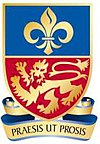Lancaster Grammar School
 |
|
| Motto | Praesis ut Prosis, ("Lead in order to serve") |
|---|---|
| Established | c. 1235 |
| Type |
Academy Grammar school Day and boarding school |
| Headteacher | Dr Christopher Pyle |
| Founder | John Gardyner |
| Location |
East Road Lancaster Lancashire LA1 3EF England |
| DfE URN | 136742 Tables |
| Ofsted | Reports Pre-academy reports |
| Students | 1,045 |
| Gender | Boys |
| Ages | 11–18 |
| Colours | |
| Publication | The Lancastrian |
| Former pupils | Old Lancastrians |
| Website | www |
Lancaster Royal Grammar School (LRGS) is a selective grammar school (day and boarding) for boys aged 11–18 in Lancaster, Lancashire, England. It also has academy status. Old students belong to The Old Lancastrians. The school values sporting success as well as academic. It is one of England's 36 state boarding schools.
The school was founded between 1235–1256, probably nearer to the former, and was later endowed as a free school by John Gardyner. The first definite mention of the old grammar school is found in a deed dated 4 August 1469, when the Abbess of Syon granted to John Gardyner, of Bailrigg (near Lancaster), a lease of a water-mill on the River Lune and some land nearby for two hundred years to maintain a chaplain to celebrate worship in the Church of St. Mary, Lancaster, and to instruct boys in grammar freely, "unless perchance something shall be voluntarily offered by their friends".
In 1472, John Gardyner's will made further provisions for the endowment of the school, and also for William Baxstonden to keep the school so long as he could teach the students. In 1682, the school was rebuilt and in 1852 was removed from the old site on the slopes by the priory to the outskirts of the city, where it now stands (though the city has expanded beyond it).
This building (now known as Old School House), which stands on the north side of East Road, was designed by the local architects Sharpe and Paley at a cost of £8,000 (equivalent to £780,000 in 2015). The foundation stone was laid on 5 May 1851 by Rt Revd James Prince Lee, the Bishop of Manchester. The title "Royal" was granted by Queen Victoria in the same year. This building is recorded in the National Heritage List for England as a designated Grade II listed building.
...
Wikipedia
